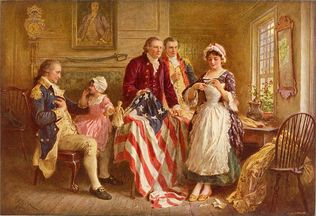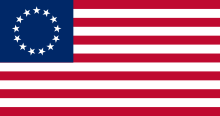 Betsy Ross, 1777 (Ferris, ca 1920) Growing up in Philadelphia, I was both immersed in and oblivious to the colonial history that surrounded me. After school my friends and I often went to the mall by the Liberty Bell or we hung out in beautiful Independence Square, within a few yards of where the Declaration of Independence was signed, rarely heeding the significance of our historic surroundings. I admit, sometimes we'd laugh at the tourists snapping countless pictures, reading signs, peering at maps, buying outrageously expensive soft pretzels (everyone knew you don't buy them in the tourist areas!), pitching pennies on Ben Franklin's grave (years later, I understood why they did that--they were paying homage to the man who coined the phrase in his Poor Richard's Almanac, "A penny saved is a penny earned"--but at the time we thought it was a pretty silly thing to do.) Hey, we were kids. But I'm sure if someone had asked, we'd have been able to give a decent enough explanation of the events leading to the break with Great Britain, maybe something about John Hancock and Thomas Jefferson, etc. Heck, I'm sure we could have offered up the great tale of how Betsy Ross was asked by none other than George Washington himself to create the first American flag. And how that flag she sewed, with its unique star pattern, helped inspire a burgeoning nation to independence and unity. Or something along those lines. You don't mess with Betsy Ross. But as a historian now, I look back and question how history and legend became intertwined with our local popular memory and national identity. Only a little digging reveals that few vexillogists (people who collect and study flags, and also my new favorite word) and historians agree with the popular conviction that Philadelphia seamstress Elisabeth Griscom Ross (a.k.a. Betsy Ross, revered national icon) actually made that first flag (let alone that General Washington commissioned it). Indeed, the evidence appears to be scant one way or the other, and heavily anecdotal in nature. Much of the sentimental legend appears to have derived from a popular account put forth by Ross's daughter, and related in full by her grandson, in the late nineteenth century. Even then, however, scholars seemed a bit skeptical about the veracity of the legend, but the romantic quality seems to have captured the imagination of Ross's biographers, and the legend somehow became true. (Noted historian Laurel Ulrich offers an excellent discussion of how this transpired, and why Betsy Ross is still an important figure in U.S. history).  Another vexillogy related point (and yes, I am hoping to use that word repeatedly)--is the so-called "Betsy Ross five-pointed star pattern." Again, all kinds of myths abound about the origins of this type of star: some argue that the stars were connected to George Washington's family crest (doubtful, despite the red stars on the crest, given that this was the same man who would not be king); or perhaps to European heraldry (maybe some influences here), or most likely to the early naval signs. Say what you will--my money is on the alleged connection of the early founding fathers to the Masonic order (supposedly stars were one of their symbols, along with pyramids etc. The Da Vinci Code in America, anyone?) Even though legends about Betsy Ross and the flag are enjoyable, I think it's important to consider their origins. But what do you think?
3 Comments
bekerys
7/6/2012 07:19:02 pm
Okay, Philly girl, don't mess with our legends! Don't try to put facts into a discussion on Betsy Ross. I mean, really, next you'll be saying that the soft pretzel didn't originate here!
Reply
8/13/2013 10:00:06 pm
Hmm. Never known the history behind the American flag. Thanks for the post. I will keep the story of Betsy Ross and the flag. The American flag evolved a lot. Compared to the first flag, the current one is much better.
Reply
Leave a Reply. |
Susanna CalkinsHistorian. Mystery writer. Researcher. Teacher. Occasional blogger. Categories
All
Archives
May 2023
|
 RSS Feed
RSS Feed